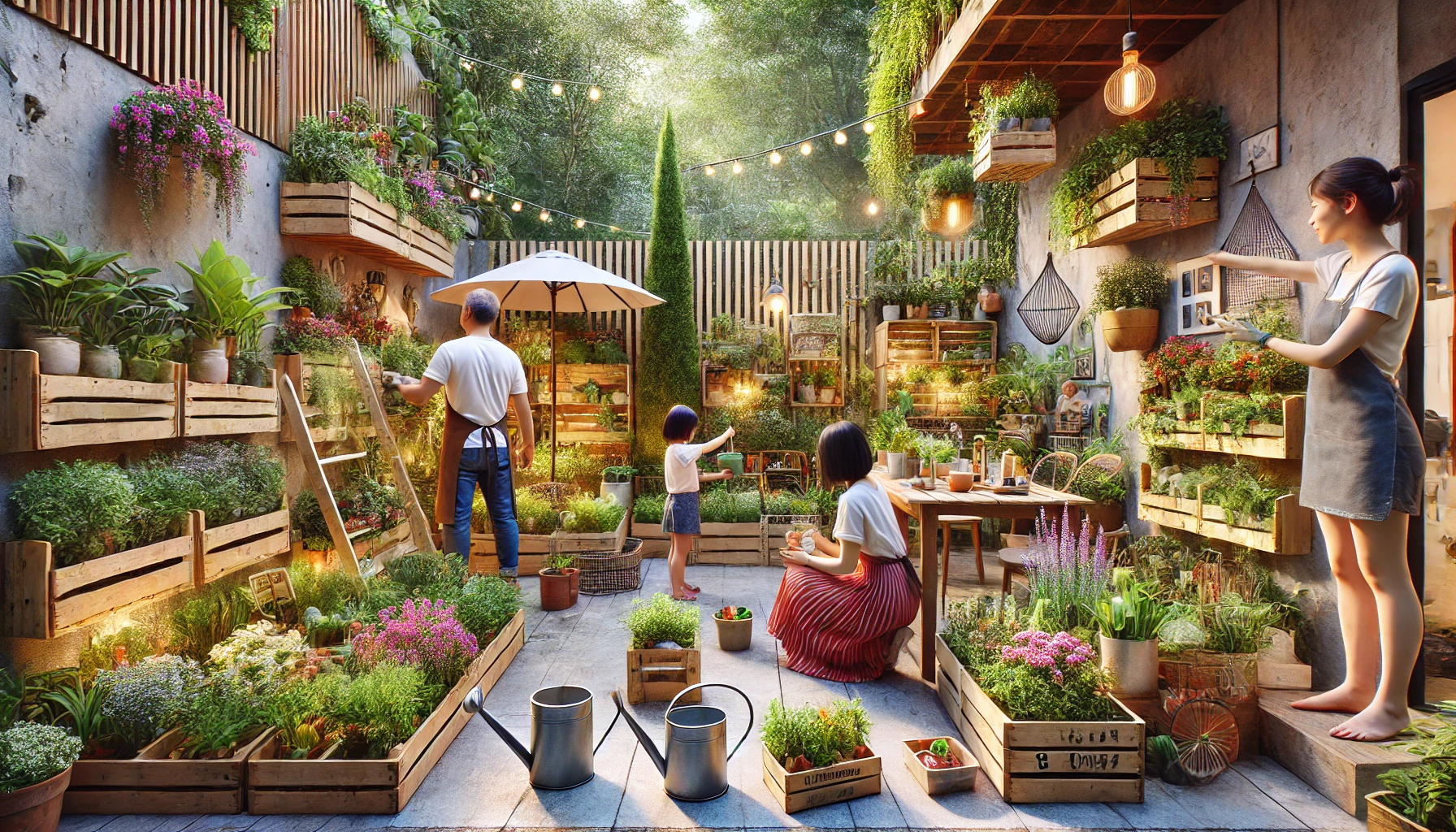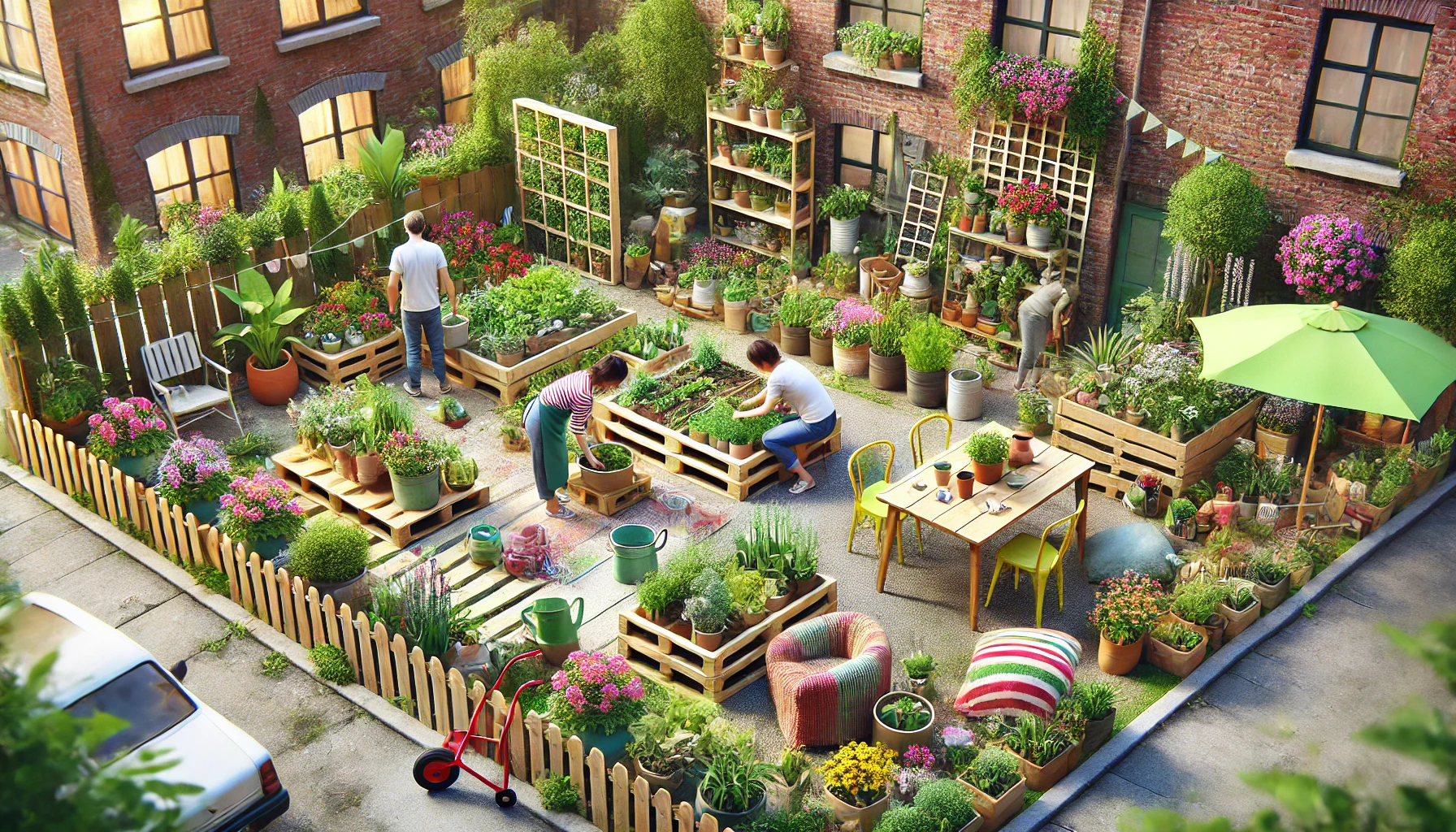Creating a beautiful garden doesn’t have to drain your wallet. Ideas for small gardens on a budget are often more about thinking smart than spending big. Basic landscaping techniques are a great starting point. You’d be surprised how much you can achieve with a bit of know-how and a can-do attitude.
DIY is your friend here. By taking on some of the work yourself, you’re not just saving cash—you’re putting a personal stamp on your garden. Think about building your own planter boxes or setting up rustic pathways. It’s all about working with what you’ve got and tapping into your creativity.
Choosing the right materials can make a world of difference too. Look out for sales, or even second-hand materials. Reclaimed wood, for example, can offer a unique look without costing a fortune. Also, simple decorations like gravel or pebbles can give your space an upscale feel without the upscale price.
When it comes to plants, focus on those that give you the most bang for your buck. Perennials, for instance, return year after year. They might cost a bit more upfront but consider the savings when you don’t have to replant every season. Similarly, consider seeds instead of mature plants—they’re much cheaper and grow quickly with a little care.
Lastly, think vertically. Especially in a small garden, using vertical space maximizes what you can achieve within your area. Use climbers on trellises or fences to add layers and depth. It’s about making the best use of every square inch and setting the stage for lush, affordable greenery.
Creating a Low Maintenance Garden for the Elderly
Gardening should be a joy, especially for our elderly folks who deserve a space that’s as easy to care for as it is lovely. A garden that practically takes care of itself lets them enjoy the beauty without too much hassle.
Start by picking plants that don’t demand constant attention. Think about perennials and native species—they’re adapted to the local climate, thrive with minimal care, and bring annual color to the yard.
Raised beds are a game-changer. By lifting the garden, you’re making it easier on those knees. Plus, they help with drainage and keep the yard looking tidy and organized.
Simplifying the watering process is key. Drip irrigation systems and self-watering pots reduce the need for daily attention, saving time and effort. Once set up, these systems ensure plants get the right amount of water without any fuss.
Adding a seating area transforms any garden into a little slice of heaven. Comfortable benches or chairs amid fragrant blooms and greenery invite the elderly to take in the surroundings without needing to bend or kneel. It’s all about creating a soothing, accessible space that grows happiness along with every flower.
Starting a Garden With Little Money
Kicking off a garden project doesn’t mean emptying your savings account. You can get your patch of green thriving with just a sprinkling of ingenuity and a smidge of resourcefulness.
Think outside the box when it comes to materials. Old pallets, plastic bottles, and even worn-out tires can be transformed into planters. It’s not just eco-friendly; it brings character to your space without costing a dime.
Hook up with local gardening groups or communities. They often share extra seeds, seedlings, or even tools. It’s a win-win—you save money and might just make a few gardening buddies along the way.
Online platforms like social media groups or neighborhood apps often feature freebies. Keep an eye out for plants, soil, and other gardening essentials that folks are giving away or selling cheap.
Homemade compost is like black gold for garden enthusiasts. Recycle kitchen scraps and yard waste into nutrient-rich fertilizer—your plants will love it, and your wallet will too.
For those essential tools, check out thrift stores and garage sales. Gently used tools can last years, and the bargains leave more room in the budget for those quirky garden ornaments you’ve been eyeing.
Enhancing Small Garden Aesthetics
Your small garden can punch well above its weight with the right tricks up your sleeve. Start by playing with color. Colors can’t just change the mood of a space but also make it feel larger. Think about pairing bright containers with lush green foliage, creating focal points that draw the eye.
Vertical gardening isn’t just for show; it’s a space-saver. Use walls, fences, or even wooden ladders to display hanging pots or climbing plants. This not only frees up ground space but adds a layer of visual interest.
Invest in multifunctional furniture. A bench that doubles as storage or a table that can expand for guests means you’re ready for anything without crowding the garden. It’s all about making the most of your limited area.
Lighting can transform your garden from day to night. The right solar lights or string LEDs bring warmth and charm, highlighting key features and setting the scene for evening relaxation.
Don’t neglect the simple pleasures of water features. Even small fountains can be soothing and attract birds, adding life to your garden. It’s the tranquility that packs a mighty punch, enhancing both the soundscape and landscape.

Maximizing Limited Garden Space
When space is at a premium, every inch counts, but there are clever ways to make the most of what you have. Get inventive with your garden layout by incorporating different levels. Raised beds, hanging baskets, and tiered planters add layers and dimension, allowing for more plant variety without overcrowding.
Mirrors are a bit of a magic trick for small spaces. Strategically placed, they reflect light and create the illusion of a larger area. It’s a simple, effective way to brighten and expand the feel of your garden.
Think beyond the horizontal. Vertical gardening techniques mean you can grow herbs, flowers, or even veggies upwards. This not only optimizes space but also makes for a visually interesting display.
Multipurpose spaces should be the aim. Incorporate areas that can serve multiple functions, like a deck blurring the line between dining zone and garden. It’s all about maximizing utility while still enjoying the bursts of nature every time you step outside.
Lastly, decluttering is vital. Regularly assess and eliminate what no longer serves your vision or function. A tidy, well-organized garden feels bigger and more inviting, giving you room to enjoy your surroundings to the fullest.
Balancing Aesthetics and Budget
Creating a garden that fits both your budget and aesthetic desires might seem like a tall order, but it’s all about smart planning and a dash of creativity. Start by setting a clear vision. Knowing what you want helps in prioritizing expenses, so you invest in things that matter most to you.
A trick to keeping costs down while staying stylish is thinking seasonally. Rotate plants and decorations to keep the look fresh and your spending in check. Seasonal plants offer vibrant options that keep your space looking lively all year round without needing a total overhaul.
Consider the long-term benefits of certain features. Things like perennials or solar-powered lights might have a higher immediate cost but save you time and money down the road. It’s about thinking of the garden as an evolving project rather than a one-time expense.
Gardening is an opportunity to reflect your personality. Don’t shy away from quirky features or upcycled materials that speak to your taste. It’s these unique touches that make your garden a personal labor of love.
Ultimately, the garden should be a source of joy. Take pride in the little victories along the way, and remember, it’s less about achieving perfection and more about creating a space that you love and can enjoy, rain or shine.


Hey there, Herman,
The article focuses on budget-friendly gardening techniques that help maximize space, enhance aesthetics, and reduce maintenance, all while keeping costs low. It highlights smart landscaping strategies, DIY approaches, and resourceful material choices to create beautiful gardens without overspending.
Key Themes:
1. Budget Gardening Strategies
2. Utilize reclaimed materials (pallets, old tires, second-hand tools)
3. Grow cost-effective plants (perennials, seeds instead of mature plants)
4. Use composting for natural, free fertilizer
Balancing Beauty and Budget
1. Invest in long-term solutions like perennials and solar lights
2. Rotate seasonal plants and decorations to refresh the space
3. Incorporate DIY and upcycled elements for a personal touch
The overarching message is that a stunning garden doesn’t have to be expensive—it just requires creativity, smart planning, and resourceful use of materials.
Thanks for sharing the article overview! It sounds like a fantastic resource for anyone looking to create a beautiful garden without breaking the bank. I love the emphasis on reclaimed materials, DIY solutions, and cost-effective plant choices—definitely valuable tips for both beginners and seasoned gardeners.
I especially appreciate the focus on balancing aesthetics with budget-friendly strategies, like investing in long-term solutions and incorporating upcycled elements. These approaches not only save money but also add a unique, personal touch to any garden space.
Looking forward to reading the full article! Let me know if you’d like me to share any additional insights or feedback.
Best,
Herman